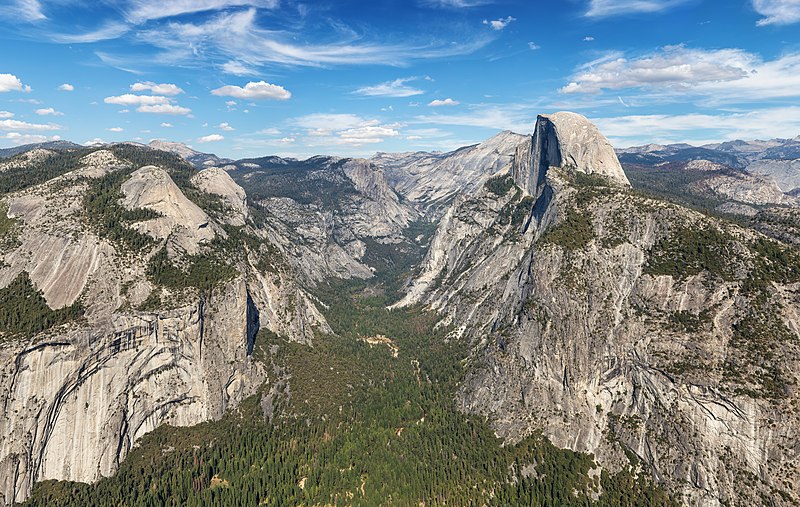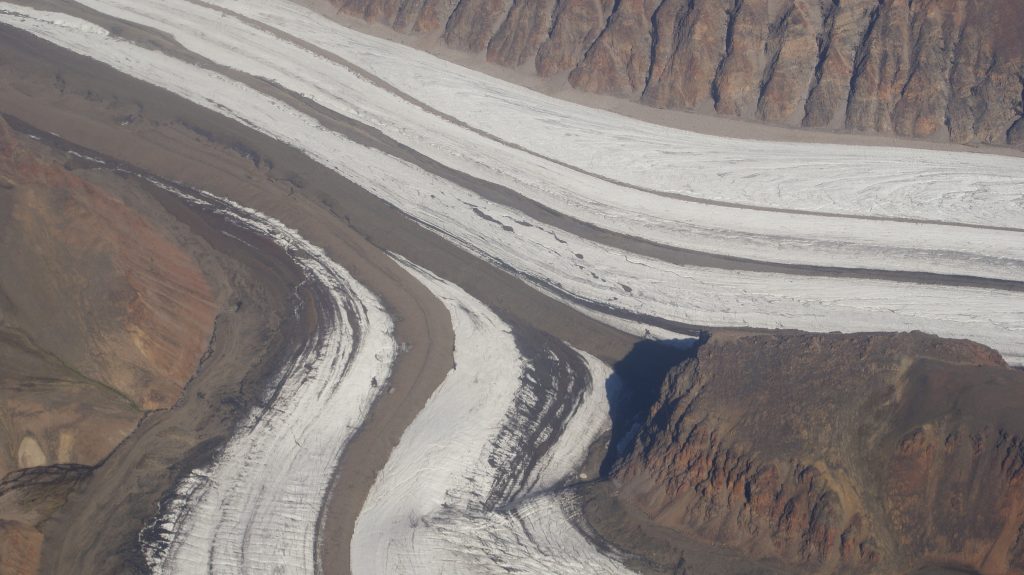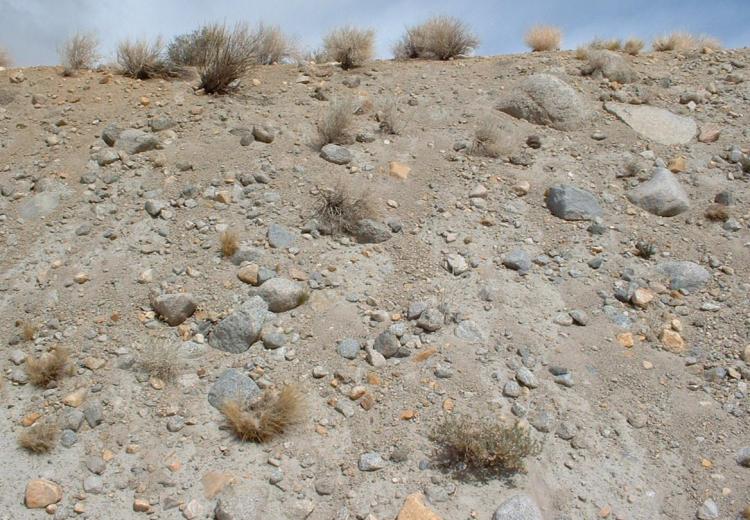Glacier Deposits
- Page ID
- 10912
Overview
Glaciers erode and transport rock as they flow down slope. Then, when the glaciers start to melt or recede, the sediment is deposited as unsorted glacial till, often in characteristic landforms such as moraines and their associated sedimentary facies.
Glacial Erosion and Transport
Erosion
Because glacial environments are so cold, glacial erosion tends to be physical rather than chemical. Erosional processes include:
- Rocks breaking due to water freezing and expanding in fractures
- Rocks picked up off the valley floor by the base of a flowing glacier
- Rocks grinding against each other or the floor of the glacial valley as they are transported by flowing ice.
These processes produce certain distinctive sedimentary features:
- Clasts with smooth facets where they were dragged against other rocks
- Rocks with striations and grooves where they were dragged against other rocks
- Valley floors that have been eroded flat
- "Rock flour" made of clay-sized lithic grains.
Glacial erosion is also associated with erosional landforms such as U-shaped valleys, cirques, and aretes.

Figure 1: Yosemite Valley is a U-shaped glacial valley.
Laminar Flow
Because ice is much more viscous than water or wind, sediment in a glacier is transported by laminar flow instead of turbulent flow. In laminar flow, the fluid particles (in this case, ice serves as a highly viscous fluid) flow in straight layers parallel to the direction of current, with minimal mixing. In a glacier, this means that any sediment and debris that gets incorporated into the body of ice will be carried alongside other grains as the glacier flows without becoming sorted by grain size as they would in water. The grains will not mix into the rest of the glacier, and as a result they tend to form sediment-rich bands in zones of heavy erosion such as the outer edges of a glacier.

Figure 2: Two converging glaciers carrying sediment as they flow towards the upper left corner of the image. Notice the bands of sediment, and the way these bands converge where the two glaciers meet.
Figure 3: A video demonstrating laminar flow (bottom) vs turbulent flow (top) of dye in water.
Glacial Deposition
Till
As the glacier melts or sublimates, all of the sediment carried in the glacier is freed from the ice as it recedes. Grains transported by ice, unlike those transported by water, are not sorted by size (though streams of meltwater may sort and transport the sediment after deposition). Once this pile of sediment is cemented into a rock, the result is a diamictite, a sedimentary rock made up of unsorted grains. A more specific name for an unsorted sedimentary rock with grains deposited by ice is a tillite. The loose sediment is called till in its unlithified form.

Figure 4: Glacial till. Notice the range of grain sizes mixed together with no sorting.
Moraines
A moraine is a ridge-shaped mound of till that forms as a glacier recedes. There are different types of moraines that are named depending on which part of the glacier the sediment comes from.
-
A terminal moraine is a moraine that forms at the edge of a glacier's farthest extent. As the glacier melts and recedes, recessional moraines will form upslope from the terminal moraine, on land that was once covered by the glacier.
- Moraines also form along the sides of a retreating glacier; these are known as lateral moraines. Sediment tends to gather on the sides of glaciers from erosion or mass wasting of glacial valley walls. If there was a sediment-rich band in the center of the glacier, this will form a medial moraine. Such bands form when two tributary glaciers join together.
- In the space the receding glacier once occupied within the moraines, the bedrock is covered by a thinner layer of till called a till sheet or ground moraine.
Figure 5: Lateral moraines protrude from both sides of a glacial valley, and a terminal moraine dams a proglacial lake.

Figure 6: In this close-up image, you can see the till that makes up this moraine.
Glacial Erratics and Dropstones
Ice is capable of carrying very large, heavy pieces of rock. When the glacier melts, it may leave behind rocks that have been transported a great distance and seem out of place in their new environment. A glacial erratic is a large rock that is left behind by a retreating glacier. Because they were transported by the ice, the erratics are usually made of a different rock type than the local bedrock in the place they are deposited.
A dropstone is deposited in a similar manner, but in a marine or lacustrine environment as an iceberg (a fragment of a glacier floating in water) melts and drops any sediment that was trapped in the ice. Dropstones tend to be much larger than the fine-grained sediment found in marine environments.
Meltwater Structures
After the sediment is deposited by a receding glacier, it is often rearranged by the meltwater flowing from the glacier. This secondary process of transport and deposition creates additional glacial landforms. Unlike till, these structures are generally sorted by grain size because the main agent of transport is flowing water.
- Water flowing along the base of the glacier carries and deposits sediment in a manner similar to a river. An esker is a sinuous ridge made of sediment, formed by the flow of a meltwater stream below the ice. As the glacier melts and recedes, the esker is exposed.
- When water flows on top of or through the ice it may deposit sediment that gradually accumulates into a mound. As the glacier recedes, the mound is left behind forming a hill called a kame.
- A drumlin is another type of glacial hill, characterized by their asymmetrical shape with one steep side facing opposite the direction of glacial flow, and one elongate, gently sloped side pointing in the flow direction. The method of their formation is still debated.
Glacial Facies Assemblages
Moraine Facies
This facies consists of mounds (morraines) of diamictite. The clasts are mostly lithic fragments, including silt and clay-sized rock flour. The clasts tend to be angular, and some may have facets and striations.
Till Sheet Facies
This facies is composed of planar sheets of diamictite. Shale and sandstone interbeds are rare, and structurally resemble turbidites. The clasts are similar to those in the moraine facies: angular lithic fragments with some facets and/or striations and silt and clay-sized rock flour.
Distal Glacial Lacustrine/Marine Facies
Consisting of sediments deposited in proglacial lakes and similar marine environments, the distal glacial facies is characterized by interbedded shale and sandstone with structures resembling turbidites. Large isolated clasts (mostly angular lithic fragments) are found in the shale and decrease in frequency as distance from the glacier increases.
Related Libretexts pages:


